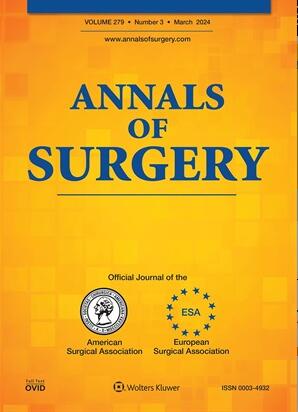利用姜黄素辅助多光子激光成像技术研究赫氏胃肠病肠神经网络的动态病理变化
IF 7.5
1区 医学
Q1 SURGERY
引用次数: 0
摘要
在活体组织中,很难在不损伤组织的情况下进行显微水平的观察。摘要 背景资料我们发明了一种用于实时观察组织的新型体内荧光观察法(IFOM),它将多光子激光扫描显微镜(MPLSM)与姜黄素重要染色法(CVS-IFOM)相结合。本研究的目的是利用 CVS-IFOM 分析小鼠和人类胃下垂和赫氏咽鼓管病患者的肠道神经系统(ENS)。方法在最初的活力研究中,我们使用 MPLSM 比较了用姜黄素染色的无荧光 C57BL6 小鼠(n=5)和 GFP 小鼠(n=5)的活体 ENS 图像。然后,我们对 CVS-IFOM 进行了探索,以便对一名结肠功能减退症患者和三名赫氏普隆病患者切除的结肠组织进行活体检查。结果在存活率研究中,仅在姜黄素染色的小鼠中观察到详细的 ENS 组织学特征。在肌张力减退症患者中,CVS-IFOM 提供了在 H&E 染色或钙网蛋白免疫组化中无法观察到的 ENS 细节,从而可以分析 ENS 的大小、神经束数量和每个神经丛的神经细胞数量。在赫氏咽鼓管病患者中,CVS-IFOM 显示从口腔楔到肛门楔的 ENS 逐渐变小,检测到同一肠层中 ENS 的不成比例变化,支持肠道 ENS 的周向不均匀分布。本文章由计算机程序翻译,如有差异,请以英文原文为准。
Dynamic Pathology of Enteric Neural Network using Curcumin-assisted Multiphoton Laser Imaging in Hirschsprung Disease.
OBJECTIVE
In living tissue, it has been difficult to make microscopic-level observations without damaging the tissue.
SUMMARY BACKGROUND DATA
We have invented a novel intravital fluorescent observation method (IFOM) for real-time tissue observation, combining multi-photon laser scanning microscopy (MPLSM) with curcumin vital staining (CVS-IFOM). The aim of this study was to use CVS-IFOM to analyze the enteric nervous system (ENS) in mice and human patients with hypoganglionosis and Hirschsprung disease.
METHODS
In an initial viability study, we compared live ENS images from non-fluorescent C57BL6 mice stained with curcumin (n=5) and GFP mice (n=5) using MPLSM. We then explored CVS-IFOM for the live examination of resected colon tissues from one hypoganglionosis and three Hirschsprung disease patients.
RESULTS
In the viability study, detailed ENS histological features were only observed in the curcumin-stained mice. In the hypoganglionosis patient, CVS-IFOM provided ENS details that were not visualized under H&E staining or calretinin immunohistochemistry, allowing the analysis of ENS size, neural bundle number, and neural cell number per plexus. In Hirschsprung disease patients, CVS-IFOM showed a gradual hypoplastic change in the ENS from the oral wedge to the anal wedge, detecting disproportionate changes in the ENS within the same intestinal level, supporting a circumferentially uneven distribution of the intestinal ENS.
CONCLUSION
CVS-IFOM may be supportive for intraoperative pathological diagnosis during surgeries in Hirschsprung disease.
求助全文
通过发布文献求助,成功后即可免费获取论文全文。
去求助
来源期刊

Annals of surgery
医学-外科
CiteScore
14.40
自引率
4.40%
发文量
687
审稿时长
4 months
期刊介绍:
The Annals of Surgery is a renowned surgery journal, recognized globally for its extensive scholarly references. It serves as a valuable resource for the international medical community by disseminating knowledge regarding important developments in surgical science and practice. Surgeons regularly turn to the Annals of Surgery to stay updated on innovative practices and techniques. The journal also offers special editorial features such as "Advances in Surgical Technique," offering timely coverage of ongoing clinical issues. Additionally, the journal publishes monthly review articles that address the latest concerns in surgical practice.
 求助内容:
求助内容: 应助结果提醒方式:
应助结果提醒方式:


